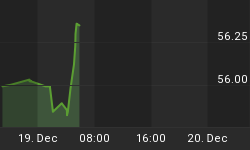Metals investors are anxiously awaiting the market’s reaction to next week’s Fed meeting. We may see players in the futures markets move to smash gold and silver prices down to lower support zones in the trading around the Fed’s decision.
But flushing out some more speculative longs and late comers with weak hands would be a healthy development in setting up the next rally.
Those who got left behind in this summer’s big moves in metals markets should certainly consider taking advantage of favorable buying opportunities as they present themselves ahead of a possible seasonal push higher in the sector this fall.
Conventional financial markets could become volatile as uncertainties surrounding America’s economy and political future weigh on investors. We are potentially only one election away from falling into socialism and one quarter’s GDP report away from falling into recession.
Lately, the mainstream media has been fixated on the possibility of the Trump economy heading toward recession.
Yes, at some point there will be a recession. But it’s not here yet. And economic forecasters as a whole have a terrible track record when it comes predicting major turns in the economy.
All the recession talk now spewing from the media is speculative at best – politically calculated at worst. Let’s face it, some anti-Trump partisans in the media are giddy over the potential for a recession to bring down the President’s poll numbers.
That said, we do see signs of an economic slowdown of at least some magnitude. Despite a low official unemployment rate, jobs are being created at the slowest pace since 2011. Corporate earnings growth is also weakening. And GDP growth in the in the second quarter fell from 3% to 2%.
Other indicators suggest recession fears are overblown – or at least premature. Household purchasing power remains strong. The stock market is trading up near record highs. And the yield curve is no longer inverted. Long-term bond yields spiked this week as the latest CPI report showed core inflation picking up. Related: How The Government Is Wasting Tax Money This Year
However, copper and other industrial metals are struggling to gain ground as the PMI manufacturing data has slumped to a multi-year low. Weakness in industrial output comes largely as a result of the ongoing trade war between the U.S. and China.
This week, the Trump administration touted some potential breakthroughs with China. Beijing will reportedly agree to buy more agricultural products from U.S. farmers. That news sent grain futures surging.
If more progress is made in resolving trade disputes, then the economic growth numbers could tick up and spoil the recession hopes and dreams of Trump’s Democrat rivals.
The biggest wild card for President Trump’s re-election prospects could be the Federal Reserve. Although Fed officials are finally cutting rates, they aren’t doing so rapidly enough as far as Trump is concerned.
This week he called Jerome Powell and company “boneheads” for keeping rates too high. Trump suggested the Fed should take rates down to zero, or even into negative territory, to bring the U.S. more in line with the rest of the world.
On Thursday, the European Central Bank lowered its rate on deposits from banks down yet another notch to negative 0.5%. The ECB also announced it would restart its bond-buying program and pump 20 billion euros a month into government and corporate bonds. Related: Supply Concerns Halt Expansion On Tianqi Lithium Plant
Next week the Federal Reserve will make its move. It is widely expected to cut rates by 25 basis points.
The race to depreciate national currencies is on. Central bankers and politicians will be undeterred as long as they see no major inflation consequence to their actions. But inflation can creep up slowly before it spirals out of control like it did in Zimbabwe.
As it would happen, former Zimbabwean dictator Robert Mugabe passed away last Friday. His heavy-handed socialist policies turned what was a prosperous and stable country known as Rhodesia under British rule into a hyperinflationary hellhole. The central bank of Zimbabwe began issuing its common currency in trillions of dollars per note.
Of course, none of the “trillionaires” created by the Zimbabwe hyperinflation actually gained wealth as a result. Instead, they lost purchasing power minute by minute while they held their rapidly depreciating Zimbabwe dollars.
There’s a lesson in there for all holders of fiat currencies – particularly in an age where central banks are taking interest rates on their depreciating paper into negative territory.
By Mike Gleason, Money Metals Exchange
More Top Reads From Safehaven.com:

















